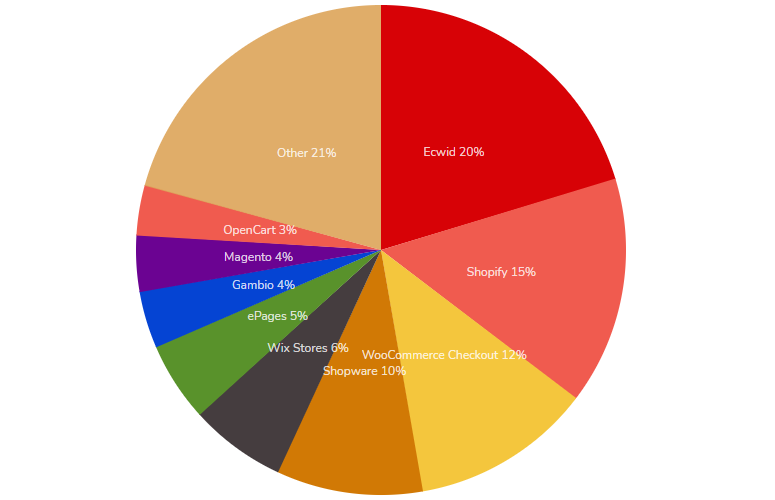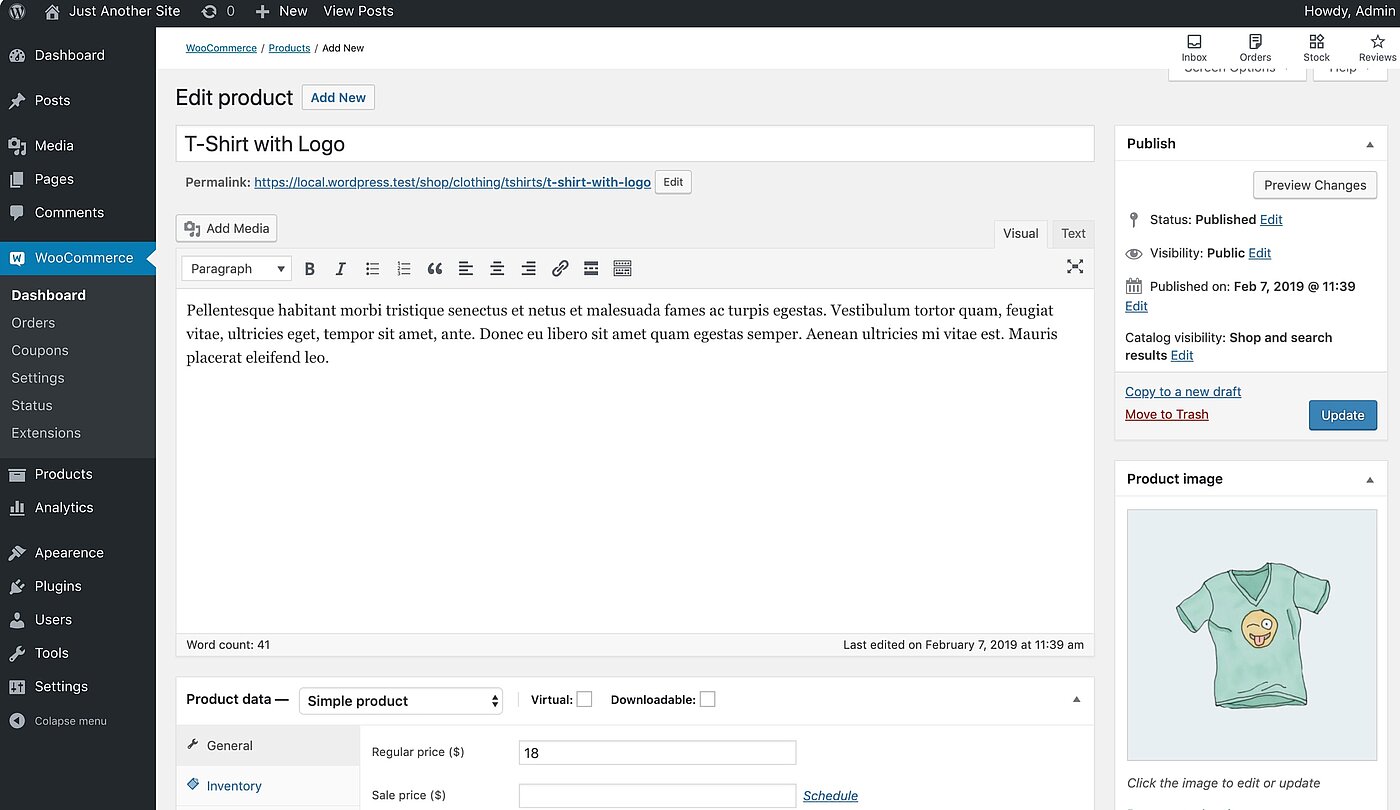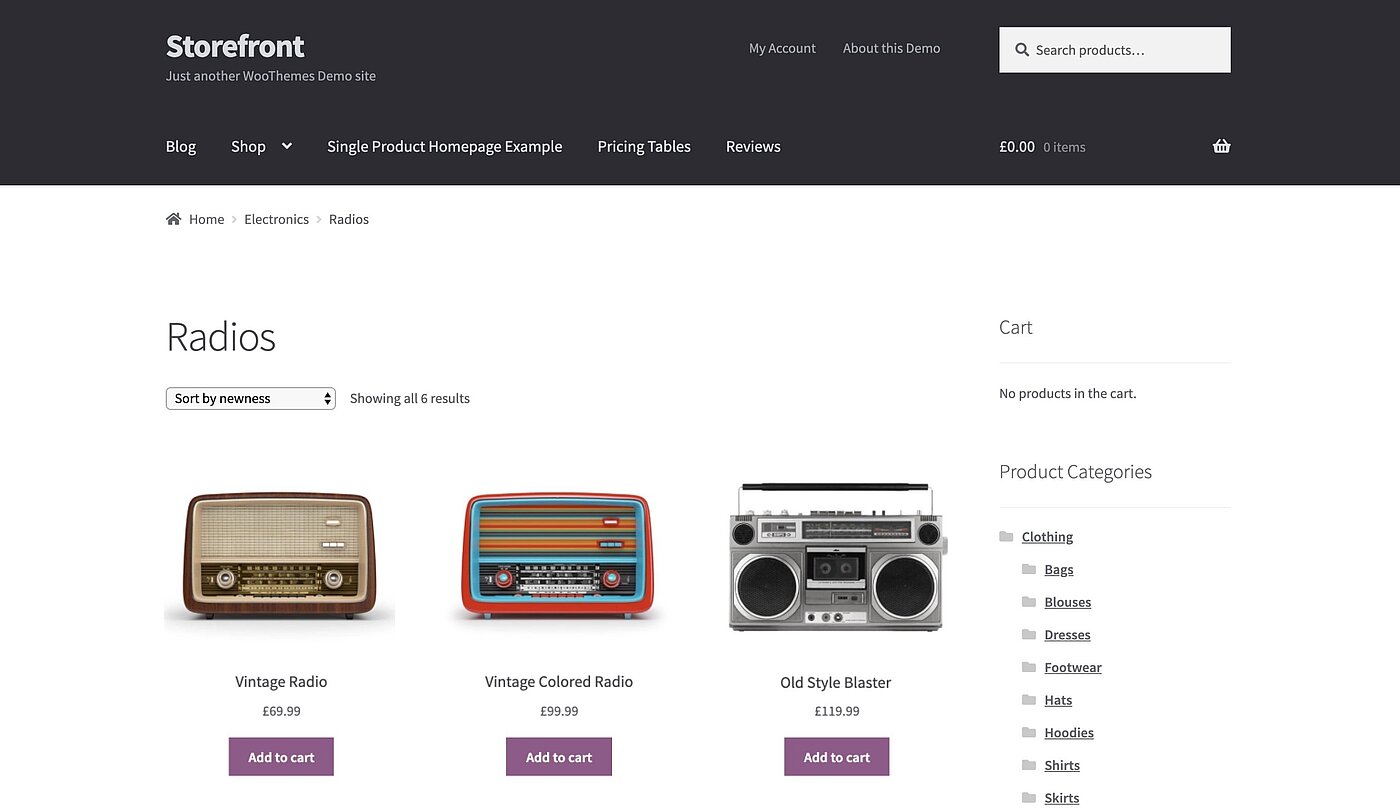
Wer sich mit E-Commerce-Lösungen beschäftigt, stößt früher oder später auch auf den Namen “WooCommerce”. Was das populäre WordPress-Plugin alles kann, erfahren Sie in diesem Artikel.
Laut BuiltWith liegt der weltweite Marktanteil von WooCommerce im Bereich E-Commerce bei 25 %. In Deutschland sind es immerhin 12 % Marktanteile. WooCommerce ist also auf internationaler wie nationaler Ebene ziemlich beliebt. Wir nehmen die Lösung im Folgenden genau unter die Lupe, geben einen Überblick über den Aufbau und die Funktionen und zeigen auf, für wen der Einsatz von WooCommerce besonders lohnenswert ist.

Marktanteil von WooCommerce in Deutschland | Quelle: BuiltWith
WooCommerce im Überblick
Was ist WooCommerce?
Bei WooCommerce handelt es sich um eine 2011 erschienene, auf PHP basierende E-Commerce-Lösung, die als Open-Source-Software zur Verfügung steht. WooCommerce ist jedoch kein eigenständiges Shopsystem, sondern eine Erweiterung des Content-Management-Systems WordPress. Die Kernplattform ist kostenlos und aktuell in 65 verschiedenen Sprachen verfügbar. Sie lässt sich einfach installieren und mit nur wenigen Klicks in eine bestehende WordPress-Website integrieren. Außerdem können die Funktionen der Plattform über den WooCommerce Marketplace mithilfe von zahlreichen kostenfreien und gebührenpflichtigen Plugins erweitert werden.
Aufbau von WooCommerce
Nach der Installation ist WooCommerce über das WordPress-Backend erreichbar und verfügt dort auch über ein eigenes Dashboard. Ähnlich wie WordPress selbst ist auch WooCommerce modular aufgebaut. Wer also bereits mit dem Dashboard von WordPress gearbeitet hat, wird auch WooCommerce schon nach kurzer Zeit versiert bedienen können. So funktioniert z.B. das Anlegen neuer Produkte im WooCommerce-Backend sehr ähnlich wie das Erstellen eines Blogartikels in WordPress.
 Erstellen von Produkten im WordPress-Backend | Quelle: WordPress
Erstellen von Produkten im WordPress-Backend | Quelle: WordPress
Mit dem Shopsystem können verschiedene Arten von Produkten abgebildet werden: Neben physischen Artikeln ist es auch möglich, digitale Produkte (z.B. mp3-, mp4-Dateien oder E-Books) einzubinden. Zudem ist WooCommerce auch für den Verkauf von Tickets für Veranstaltungen aller Art nutzbar. Die Versandart kann je nach Produkt individuell angepasst werden.
Mit den bereits integrierten Produktblöcken können außerdem Kategorien, Tags, Filter und Suchfunktionen für Produkte, mithilfe derer die Shop-Struktur und das Nutzererlebnis verbessert werden können, angelegt werden. Nicht nur viele der zum Download bereitstehenden Storefront-Themes, sondern auch das in die Plattform integrierte Standard-Theme zeichnen sich durch ein responsives Design aus. Somit ist der Shop bereits für die Darstellung auf mobilen Endgeräten optimiert.
 Frontend-Ansicht eines WooCommerce-Beispiel-Shops | Quelle: WordPress
Frontend-Ansicht eines WooCommerce-Beispiel-Shops | Quelle: WordPress
Funktionen von WooCommerce
Die Kernplattform verfügt über alles, was zur Inbetriebnahme eines Onlineshops nötig ist. Wer seinen Shop auf Business-Level betreiben möchte, wird allerdings schnell feststellen, dass sie in ihrer Funktionalität limitiert ist. Wie bereits erwähnt, lassen sich über den Marketplace zahlreiche Extensions und Themes integrieren, um die Funktionalität von WooCommerce zu steigern. So kann der Shop z.B. mit einem visuell ansprechenden Storefront ausgestattet oder um Payment-, CRM-, SEO- und Webanalyse-Tools erweitert werden.
Wem das nicht genügt, der kann auf Basis von WordPress Hooks auch auf der Ebene der Entwicklung tätig werden. Mithilfe von Hooks ist es möglich, eigenen Code an bestimmten Punkten in den WordPress Core einzubinden, um Prozesse auszuführen oder zu verändern. Der WordPress Core selbst bleibt dabei unberührt. So können z.B. eigene Themes oder Plugins erstellt und in das System integriert werden.
Für wen ist WooCommerce besonders lohnenswert?
Die Relation von Kosten und Nutzen
WooCommerce besticht als E-Commerce-Lösung besonders durch die (anfangs) überschaubaren Kosten, die schnelle und unkomplizierte Einrichtung, eine hohe Usability sowie die Vielfalt an möglichen Modifikationen. Für die Installation und Einrichtung des Shop-Systems sind zunächst einmal keine CSS- oder HTML-Kenntnisse notwendig, Know-how im Umgang mit dem CMS WordPress ist aber klar von Vorteil. Ist die Einrichtung abgeschlossen, eignet sich die kostenfreie Kernplattform ideal zum Testen.
Funktionalität
Da die Funktionalität der Plattform allein ihre Grenzen hat, kann auf eine Vielzahl von Plugins zurückgegriffen werden, um die Möglichkeiten des Onlineshops zu erweitern. Das ist z.B. dann der Fall, wenn der Shop gezielter für Marketing- oder Vertriebsaktivitäten genutzt werden soll. Als Open Source ist das System zudem sehr flexibel und kann an individuelle Anforderungen angepasst sowie um eigens entwickelte Plugins erweitert werden. Ohne ausreichende Kenntnisse in der Entwicklung ist das allerdings nicht möglich.
Usability
Viele kostenfreie und gebührenpflichtige Themes zahlen durch responsives Design und übersichtliche Navigationsstrukturen auf ein positives Nutzererlebnis ein. Bei Themes von Drittanbietern sollte jedoch vor dem Kauf getestet werden, wie sich das Design auf verschiedenen Endgeräten verhält. Die Vielzahl kostenpflichtiger Extensions bedeutet aber auch, dass die Erweiterung des Onlineshops schnell zur Kostenfalle werden kann. Daher sollte bereits im Vorfeld relativ klar sein, welche Funktionen der Shop abdecken soll.
Performance
Mit der Menge an integrierten Plugins ist auch im Hinblick auf die Performance Vorsicht geboten. Je mehr Plugins genutzt werden, desto mehr Rechenleistung wird zum Betreiben des Shops benötigt. Wer also komplexere Anforderungen an sein Shopsystem hat oder einen Shop mit hohen Zugriffszahlen betreibt, muss damit rechnen, dass das System an Stabilität und Geschwindigkeit einbüßen kann oder durch die Skalierung mehr Kosten verursacht.
Zielgruppen
Die Nutzung von WooCommerce eignet sich besonders für Betreiber kleiner bis mittelgroßer Onlineshops, die diese in Eigenregie betreuen und nur ein begrenztes Budget zur Verfügung haben. Aufgrund der einfachen Integrationsmöglichkeit in ein bestehendes WordPress-System ist WooCommerce auch eine interessante Option für Blogger oder Influencer, die ihre Website um einen Onlineshop erweitern wollen. Da die elementare Plattform kostenfrei nutzbar ist, eignet sich WooCommerce zudem für experimentierfreudige Neueinsteiger im E-Commerce.
Nutzung von WooCommerce in Deutschland
Möchte man in Deutschland einen Onlineshop auf Basis von WooCommerce betreiben, sind einige Besonderheiten zu berücksichtigen. Da WooCommerce für den amerikanischen Markt konzipiert wurde, müssen Änderungen vorgenommen werden, um das rechts- und datenschutzkonforme Betreiben des Shops zu gewährleisten. So ist es bspw. notwendig, Impressum- und AGB-Seiten oder auch Zahlungsmethoden anzupassen. Dazu können Plugins wie Germanized genutzt werden. Germanized ist in der Basis-Version kostenfrei und enthält nicht nur zahlreiche Features, mit denen der Shop in Bezug auf den deutschen Markt optimiert werden kann, sondern auch Textvorlagen für rechtlich notwendige Seiten wie AGB oder Datenschutz.
Die Vor- und Nachteile von WooCommerce auf einen Blick
Vorteile | Nachteile |
|---|---|
| Kostenlose Kernplattform | Kernplattform bietet nur wenige Funktionen |
| Einfache Installation und Integration in WordPress | WooCommerce ist als Shop-Lösung an CMS WordPress gebunden |
| Funktionen sind durch zahlreiche Plugins erweiterbar | Viele funktionale Extensions und Themes sind kostenpflichtig (nicht offensichtlich) |
| International einsetzbar | Nicht für den deutschen Markt optimiert |
| Storefront-Themes mit responsivem Design | Funktionalität von Drittanbieter-Themes nicht immer sichergestellt |
| Open Source | Eingeschränkter Support (kostenpflichtig und ausschließlich englischsprachig) |
| HTML- oder CSS-Kenntnisse nicht zwingend erforderlich | Aus Performance-Sicht weniger geeignet für große und komplexe Onlineshops |
Was ist bei der Integration zu beachten?
Bevor Sie sich für eine E-Commerce-Lösung entscheiden, ist es hilfreich, sich die technischen Anforderungen anzusehen. Zunächst einmal ist WooCommerce als WordPress-Plugin an das CMS gebunden. Geht man also von der neuesten WooCommerce-Version 5.5.1 aus, so wird mindestens WordPress 5.5 oder eine neuere Version benötigt, um einen Onlineshop aufzusetzen.
Zudem basiert WooCommerce als Open-Source-Software auf der Skriptsprache PHP und ist ausschließlich mit PHP 7.4 oder neueren PHP-Versionen kompatibel. Auch das PHP Memory Limit ist von Bedeutung, denn es gibt an, wie viel Speicher ein PHP-Skript bei der Ausführung maximal beanspruchen darf. Damit es nicht zu ungewollten Störungen kommt, ist es empfehlenswert, das PHP Memory Limit auf mindestens 128 MB zu setzen.
WordPress verwendet MySQL als Datenbankmanagementsystem. Die Mindestvoraussetzung für das Betreiben eines WooCommerce-Shops ist MySQL 5.6 oder höher.
Seit Inkrafttreten der DSGVO muss die Übertragung personenbezogener Daten im gesamten EU-Raum verschlüsselt werden. Eine verschlüsselte Datenübertragung wird mithilfe eines SSL-Zertifikates hergestellt. Im hier verlinkten Beitrag erfahren Sie mehr über SSL-Zertifikate.
Damit Ihre WooCommerce-Version immer über die neuesten Sicherheits-Updates verfügt, sollten Sie das Shopsystem regelmäßig auf die neueste Unterversion aktualisieren. Auf dieser Seite können Sie überprüfen, ob Ihre WooCommerce-Version bereits auf dem aktuellen Stand ist oder ob neuere Updates verfügbar sind.
Technische Anforderungen von WooCommerce 5.5.1 im Überblick | |
|---|---|
| WordPress | Version 5.5 oder neuer |
| PHP | Version 7.4 oder neuer |
| MySQL | Version 5.6 oder neuer |
| PHP Memory Limit | 128 MB oder mehr |
| HTTPS Support | Gültiges SSL-Zertifikat |
| cURL (optional) | Nur bei Nutzung bestimmter Plugins erforderlich |
WordPress Hosting bei maxcluster
Wer einen professionellen Onlineshop betreibt, beschäftigt sich auch mit den Themen Sicherheit, Infrastruktur und Performance. Wie kann Ausfallsicherheit gewährleistet werden? Wie sorge ich dafür, dass mein Shop auch bei viel Traffic nicht an Ladezeit einbüßt? An wen kann ich mich wenden, wenn ein Problem auftritt?
Das Managed WordPress Hosting bei maxcluster beinhaltet neben der Bereitstellung, individuellen Konfiguration und Wartung der nötigen Hardware auch vollen Zugriff auf unseren E-Commerce Stack und einen rund um die Uhr erreichbaren, technischen Support.
Dienste wie Redis, Varnish oder Elasticsearch aus unserem E-Commerce Stack sind ohne Aufpreis bereits in unseren Hosting-Paketen enthalten. Über unser Managed Center können Kunden und Entwickler eigenständig Anpassungen vornehmen und die verfügbaren Tools individuell konfigurieren.
Unsere technischen Ansprechpartner im Service sind bei Fragen oder Problemen jederzeit erreichbar und lösen etwaige auftretende Probleme durch proaktives Monitoring auch vollkommen eigenständig.
Wenn Sie mehr über WooCommerce und WordPress Hosting bei maxcluster erfahren möchten, finden Sie hier weiterführende Informationen. Sie haben weitere Fragen oder benötigen Unterstützung beim Hosting ihres Onlineshops? Unser Support hilft Ihnen unter der Nummer 05251/414130 oder per E-Mail an supportmaxcluster.de gerne weiter.
Fazit
Kommen wir noch einmal zurück auf die Frage, für welche Zielgruppen WooCommerce als E-Commerce-Lösung besonders empfehlenswert ist. Eine allgemeingültige Antwort auf diese Frage gibt es nicht. Die Entscheidung für ein Shopsystem ist immer abhängig von den Anforderungen, die an dieses gestellt werden. Dafür ist es sinnvoll, vorab ein Anforderungsprofil zu erstellen. Unsere Checkliste kann Ihnen dabei behilflich sein.
WooCommerce ist eine vielseitige und bei richtiger Anwendung auch preiswerte E-Commerce-Lösung, die ihrer Popularität durchaus gerecht wird. Gerade Betreiber kleinerer und mittelgroßer Onlineshops profitieren hier von der einfachen Bedienbarkeit und der Vielzahl möglicher Funktionen.




